The position players have now joined the pitchers and catchers, spring training is in full swing. In the words of the great reliever and poet Dan Quisenberry…
Rituals of spring training
Running of sprints
A gaggle of grown men laughing at sore muscles
Omnipresence of coaches, general managers, fans, scouts…
If I close my eyes and listen
I hear the pop of ball hitting bat
Ball smothered in loved leather
And even the whoosh of ball
Spinning with raised seams cutting through air
Below, courtesy of a Bob Kendrick tweet, Buck O’Neil channeling the submarine delivery of Quiz:

Programming Note: The Royals will be on ESPN on Friday, March 5, at 2:00, playing the World Champion Los Angeles Dodgers.
Lew Krausse (RIP): During the 13 years the A’s played in Kansas City (1955-1967), there were not many highlights. But most KC fans from that era will remember a June night in 1961 when Lew Krausse, just nine days out of high school, pitched a shutout in his first major league game. A’s owner Charlie Finley had given Krausse a $125,000 bonus, and the buzz about the money and the 18-year-old major leaguer became a national story.
Lew Krausse died on February 16, 2021. He was 77.
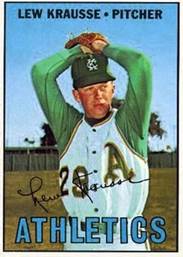
When I saw Lew’s obituary, I put in a call to Jim Chappell. I knew Jim and Lew were friends, and Jim had previously told me some Lew Krausse stories. Jim has some extra perspective because he was also a friend of Charlie Finley, a rarity among Kansas City’s population. I’ll get to Jim’s stories, but first, a look at Lew and his dad.
Lew Krausse – Senior and Junior: Lew Krausse Sr. (1912-1988; photo below) and Lew Krause Jr. (1943-2021) both pitched for the Athletics.
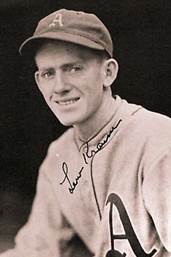
In June of 1931, Lew Sr. (without having first played in the minor leagues) joined the roster of Connie Mack’s Philadelphia A’s. He was 19, the youngest player in the American League.
In June of 1961, Lew Jr. (without having first played in the minor leagues) joined the roster of Charley Finley’s Kansas City A’s (relocated from Philadelphia in 1955). He was 18, the youngest player in the American League.
In 1932, Lew Sr. again played for the Athletics. It was his last season in the majors. But he went out on a high note. On September 2, in his final major league game, he shut out the Red Sox, winning 15-0.
In 1961, Lew Jr. debuted for the Athletics. He came in on a high note. On June 16, in his first major league game, he shut out the Angels, winning 4-0.
The father and son duo pitched back-to-back shutouts for the same team – 29 years apart.
Lew Krausse Sr. and Charlie Finley: After 1932, Lew Sr. was in the minors for several years, but he never made it back to the majors. His post-playing days included being a scout for the Athletics, and in 1961, this meant he was working for owner Charlie Finley. One of the hottest prospects in baseball that year was Lew Jr. who had pitched 18 no-hitters in amateur ball. The family connection provided an inside track for the A’s, as memorialized in a cartoon on the back of Lew Jr.’s 1963 baseball card:
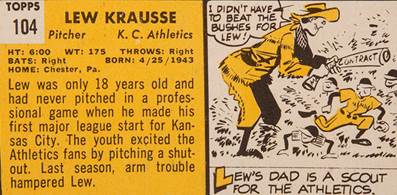
This was before there was an amateur draft, and all teams could make an offer. So Finley still had to come through with a substantial bonus – and he did – $125,000 (about $1.1 million today). He sweetened the deal by (i) signing a 5-year scouting contract with Lew Sr., (ii) giving a “beat-up” Nash Rambler to Lew Jr.’s mother, and (iii) agreeing that Lew Jr. could start his first game in the majors instead of the minors.
Lew Krause Jr.’s First Game: As Charlie Finley had promised, Lew Jr. went straight to the A’s and took the mound a week after signing his contract. The notoriety of the bonus drew a big crowd and they were in for a treat. The rookie pitcher hurled a three-hit shutout, winning 4-0. He allowed five walks, so there were plenty of base runners. But four were erased on double plays, prompting Krausse to give credit to George Toma for the manicured field so well played by SS Dick Howser (on his way to being the Sporting News Rookie of the Year), 2B Jerry Lumpe and 1B Norm Siebern.
The game was the lead on the front page the next morning in the Kansas City Times (in photo, l-r, Lew Sr., Lew Jr., Finley and manager Joe Gordon):

There was also wide national coverage for the story of a baseball prodigy going straight from high school to the big leagues. Life magazine (Princess Grace on the cover) ran a photo-spread on the game, including showing the happy baby-faced pitcher with owner Charlie Finley.


Lew Krausse Jr. – Pitching Career: For the rest of this post, I’ll drop the “Jr.” designation.
The opening success led to big home crowds in Lew’s next three starts. Finley said he probably got all of the bonus back in those first four games. But Lew’s pitching faltered, and he was demoted to the minors for the next season. He developed an elbow injury that threatened his career, but after surgery worked his way back and made the parent club for good in 1966.
Lew moved with the A’s to Oakland in 1968. His relationship with Finley deteriorated, and he was traded after the 1969 season to the Seattle Pilots. Seattle and the Kansas City Royals had just completed their first seasons as AL expansion teams. Lew went to spring training with Seattle, but the team’s bankruptcy prompted the league to approve a sale to Bud Selig who immediately moved the team to Milwaukee.
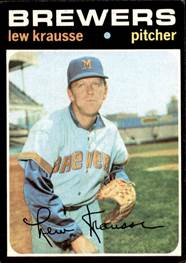
Lew was the opening day starter for Milwaukee and is remembered by Brewer fans as the first hurler to make a pitch for their new major league team. He also played for the Red Sox, Cardinals and Braves before retiring in 1975 with a career record of 68-91 and an ERA of 4.00.
The 1965 Baseball Card: Lew had two baseball cards in 1965. The first was the one on the left. There is a major issue. It’s not Lew Krausse. It’s Pete Lovrich who pitched for the A’s in 1963, his only season in the majors. Someone at Topps must have been going through file photos of A’s pitchers and got the wrong guy.
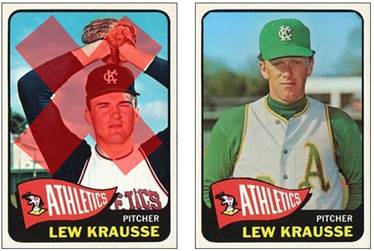
There is another flaw in the first card. The A’s had switched uniform colors in 1963. Instead of the traditional red, blue and white, Charlie Finley outfitted them in Kelly green and Ft. Knox gold. Baseball cards for some A’s players in the middle 1960s sometimes used old photos and so the switch to green and gold on cards was not always captured.
The second card corrected the mistakes, showing the real Lew in Finley’s green and gold. But if you Google Lew’s 1965 card, most of the hits are for the Lovrich version.
In 1988, when Lew turned 45, Sports Illustrated noted the occasion, but mistakenly used the Lovrich card. As soon as the magazine came out, the telephone in Lew’s home in Holt, Missouri, began ringing. Krausse: “I was tickled. Fifty people must have called, but the funny thing is that a lot of them said, ‘You really looked different when you were younger.’”
Jim Chappell and Lew Krausse: Many Hot Stove readers are familiar with Chappell’s Restaurant & Sports Museum in North Kansas City. The collection was assembled by Jim Chappell, and one of his favorite pieces is a framed copy of the Life magazine article about Lew’s inaugural game in Kansas City.

But Jim has more than memorabilia about Krausse. He has stories.
Jim opened his restaurant in 1986. It was good timing for a sports-oriented bar to open – the Royals had won the 1985 World Series. His extensive memorabilia collection drew fans and athletes, and Chappell’s became a hub of sports nostalgia and trivia.
There was another entrepreneur who opened a business in North Kansas City in the 1980s. Lew Krausse and two partners opened a metals business that prospered. Lew was a regular at Chappell’s where he could see his baseball cards and the Life article on the walls. Jim and Lew became good friends. This Rich Sugg photo from the KC Star shows Lew and Jim behind the bar at Chappell’s. They are looking at a 1974 World Series trophy that Charlie Finley gave to Jim.
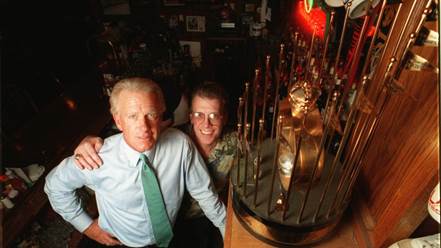
Below, some of Jim’s stories, supplemented by news reports and Jim’s book, Conversations at Chappell’s.
The Model: When Krausse was 22, he met a model who worked in New York for Faberge. When the A’s came to town to play the Yankees, Lew would give her several tickets so she could bring her girlfriends to the game. After the game, the model gave him a list of numbers – turned out to be the uniform numbers of A’s players they thought were cute. And then they would all go out. This went on for a few years. Lew: “It got to be the most important thing for some of the players after the game. Sure, we might have lost the game, but was my number on the list?”
The Airplane Ride: Krausse said he had lots of Finley stories, some not fit for print. One that became public was when Finley accused Krausse of rowdiness on a commercial flight. Lew was fined $500 and suspended by Finley. Manager Alvin Dark and several players objected to Finley singling out Krausse. Ken Harrelson was quoted in the paper as saying Finley was a “menace to baseball.” Finley fired Dark and released Harrelson who denied the “menace” comment. A bad choice for Charlie who got nothing in return for Harrelson. Turned out great for Harrelson who got a big free agent contract with Boston and helped them win the 1967 pennant.
A headline in New York’s Daily News read “Krausse Sez: Won’t Play For Finley Next Season.” But he did for two more seasons.
The Playboy: Finley may have singled out Krausse because, as Lew admitted, he had some good times with the A’s (specifically mentioning running-mates Dick Green and Catfish Hunter). “I never got caught for the best ones…we raised a little hell…If you can’t have a little fun, what’s the sense of playing.”
The quote comes from a 1970 article by Murray Chass in the New York Times. Chass contrasted Lew’s mediocre career record with his lifestyle: “He has had close to a perfect record, though, for good times.” The article was titled “Marriage, Trade Curb Playful Krausse.” The context: the A’s had traded Krausse to the expansion Seattle Pilots and he had also recently married. Lew: “I wish I had gotten married five years ago. I might have been a better pitcher.”
Before moving on, Lew had a parting message for Finley. Over the years, Lew had found himself in the “penthouse or the outhouse” with Finley. With the trade, Lew likely figured he must be in the outhouse, and he responded in kind. With a sport coat and…
The German Shepard: Finley issued green sport coats with gold flecks to his players. If a player left the team, the coat was to be returned. Lew received a call from the traveling secretary that Finley wanted Lew to mail his coat to Oakland. Lew was disgruntled about this, so he made a special delivery. He fed his German Shepard a big meal and then made him comfortable laying on the coat. After a “big dump,” Lew packaged the pyramid mound in the coat and sent it by the slowest way possible to Oakland. He got a call from Finley, “You dirty son of a bitch. You brought tears to the eyes to that poor boy when he opened the box.”
The Chauffer: Finley sold the A’s in 1981. He kept his hand in various sports projects, one of which was a fluorescent-striped football that was easier for players and fans to follow. He planned to come to Kansas City to promote the football with the National Federation of High Schools. Finley called his old friend Jim Chappell who offered to pick up Charlie at the airport. But Jim pulled a fast one. He asked Lew to do it. Finley’s $125,000 bonus baby would be the chauffer. This was 1989, some 19 years after the German Shepard saga. The years of animosity melted away and the three had a grand reunion at the restaurant (photo below, Charlie with his football, Jim and Lew).

The Rings: One of Lew’s beefs with Charlie was being traded and missing out on the A’s three World Series victories in 1972, 1973 and 1974. After the 1989 reunion with Finley, Lew asked Jim if he thought it would be reasonable to request a World Series ring from Charlie. Jim said sure, and while you are at it, get one for me. Lew called Charlie and got a “yes, but no diamonds.” The cubic zirconia version of the rings were received.
David Matson and Lew Krausse: Hot Stove regular David Matson has a Lew Krausse story. In 1967, David was 13 and preparing for his Bar Mitzvah. For the occasion, he bought a new suit at Woolf Brothers. The suit salesman was Lew Krausse. As was common in those days, players needed secondary income in the off-season to supplement their low salaries.
Krausse acknowledged the plight of players who played in the days of the reserve clause. From a 2016 interview: “We never made enough money playing. I entered into the business world and made millions!”
Impeachment and Baseball – 100 Years Ago: In early 1921, right at 100 years before Donald Trump was impeached for a second time, major league baseball was under the specter of impeachment.
In November of 1920, baseball owners named Judge Kenesaw Mountain Landis as the first commissioner of baseball. He was brought in to lend integrity to the game in the wake of the Black Sox Scandal. Landis was a federal judge in Illinois and saw no reason not to hold both positions. The baseball owners nor Congress thought this was a good idea.
On February 2, 1921, Congressman Benjamin Welty offered a resolution calling for the impeachment of Landis. On February 14th, the House Judiciary Committee voted 24-1 to investigate Landis. Welty’s term ended in March, and there was a lull in activity. After a controversial court decision by Landis in the summer, Congress worked on a bill to prohibit dual employment, but it failed by a tie vote in the Senate. In September, the American Bar Association censured Landis. Finally, in February of 1922, Landis voluntarily resigned from the bench.

Current Netflix Binge: Rita and I are into the third of four seasons of Call My Agent. French with subtitles. Fun.
Lonnie’s Jukebox – Tapestry at 50 Years: In February of 1971, Carole King released her iconic album Tapestry. Rita was a junior at UMKC and purchased the vinyl record. In 2004, some 33 years later, Carole King signed Rita’s album.

The opportunity to get Carole King’s autograph came during the John Kerry presidential campaign in 2008. The singer-songwriter was hosting “living room” fundraisers around the country for Kerry, and Rita and I went to the one held in Kansas City. Rita took her album, and with the assistance of Kerry’s Missouri co-chair Herb Kohn, it was signed. Below, Carole performing at the event and posing with Rita and Lonnie.


On the album, King sings a mix of old and new songs, all written or co-written by her. You can hear it all at this link (45 minutes).
As for this edition of Lonnie’s Jukebox, I’m going to play one of Carole’s songs from the album, but then switch to some memorable live versions from the Tapestry collection.
“It’s Too Late” by Carole King. This was her top single off the album. It went to #1 in 1971.
“You’ve Got A Friend” by James Taylor and Carole King on the Troubadour Reunion Tour in 2010. Rita and I attended the tour stop at Sprint Arena in Kansas City – a wonderful night. Taylor’s solo version of Carole’s song went to #1 in 1971. It is his only #1 song (before you ask, not “Fire and Rain” – it peaked at #3).
“A Natural Woman” by Aretha Franklin, performing at the 2015 Kennedy Center Honors with the Obamas and honoree Carole King in the audience. Carole was elated and Barack was in tears. King and her husband Gerry Goffin wrote this song in 1967 specifically for Aretha with input from Aretha’s producer, Jerry Wexler. It brought down the house at the Kennedy Center.
Tony Awards – One of the Tapestry tracks is “Beautiful” and that song became the title of the Broadway musical about Carole King’s life and music. Rita and I saw the show in New York with Irv and Sharyn Blond. We all absolutely loved Jessie Mueller’s portrayal of King. The link is to the Tony Awards ceremony in 2014, and it begins with the young Carole working with Gerry Goffin on “Will You Love Me Tomorrow.” It then transitions to the “Shirelles” singing the song (the original group took it to #1 in 1960). The finale pairs Jessie and Carole on stage with a joyous rendition of “I Feel the Earth Move.” Wow!
![I Feel the Earth Move” – Carole King & Beautiful Cast Performance 6.8.2014 [Tony Awards Official Video] | Zumic | Free Music Streaming & Concert Listings](https://lonniesjukebox.com/wp-content/uploads/2021/03/i-feel-the-earth-move-carole-king-and-beautiful-c-1.jpeg)